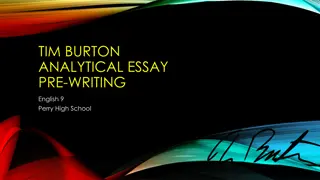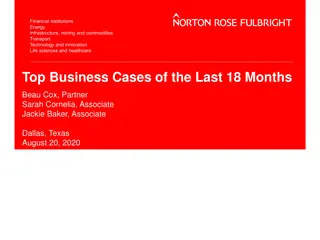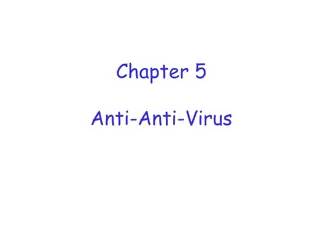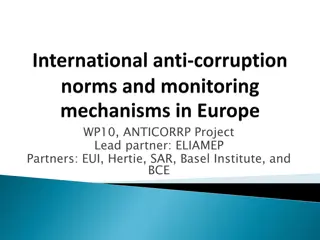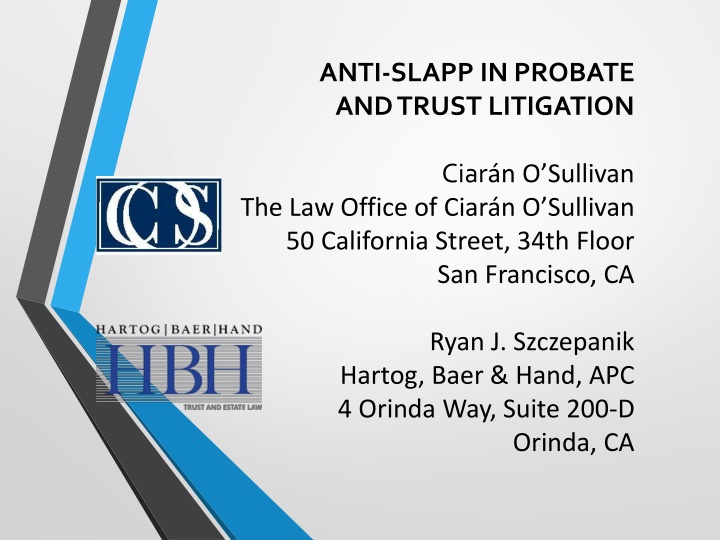
Anti-SLAPP in Probate and Trust Litigation
Explore the origins, application, and challenges of Anti-SLAPP motions in the context of probate and trust litigation. Learn about the legislative framework, burdens on parties, and the intersection with the No-Contest law. Dive into hypothetical scenarios and legislative proposals addressing issues in this specialized area of law.
Download Presentation

Please find below an Image/Link to download the presentation.
The content on the website is provided AS IS for your information and personal use only. It may not be sold, licensed, or shared on other websites without obtaining consent from the author. If you encounter any issues during the download, it is possible that the publisher has removed the file from their server.
You are allowed to download the files provided on this website for personal or commercial use, subject to the condition that they are used lawfully. All files are the property of their respective owners.
The content on the website is provided AS IS for your information and personal use only. It may not be sold, licensed, or shared on other websites without obtaining consent from the author.
E N D
Presentation Transcript
ANTI-SLAPP IN PROBATE AND TRUST LITIGATION Ciar n O Sullivan The Law Office of Ciar n O Sullivan 50 California Street, 34th Floor San Francisco, CA Ryan J. Szczepanik Hartog, Baer & Hand, APC 4 Orinda Way, Suite 200-D Orinda, CA
I. Overview Anti-SLAPP, in general Its origins When it applies The relevant procedure The burdens on the parties 2
I. Overview (Cont.) Anti-SLAPP in the Trusts and Estates context Its availability The cases discussing it The intersection with the No-Contest law The problems arising from the use of Anti-SLAPP motions in the No-Contest Context TEXCOM s legislative proposal to address those problems Hypotheticals 3
II. THE ORIGIN OF ANTI-SLAPP A Strategic Lawsuit Against Public Participation, or SLAPP suit, is a court filing complaining of injury as a result of court petitioning or free speech activity. A SLAPP suit is controversial: its intent often is to intimidate perceived adversaries by burdening them with the expense of a legal defense until they are silenced. 4
II. THE ORIGIN OF ANTI-SLAPP (Cont.) In 1992, the Legislature enacted Code of Civil Procedure section 425.16 to address the abuse of SLAPP suits. Section 425.16(a): The Legislature finds and declares that there has been a disturbing increase in lawsuits brought primarily to chill the valid exercise of the constitutional rights of freedom of speech and petition for the redress of grievances. The Legislature finds and declares that it is in the public interest to encourage continued participation in matters of public significance, and that this participation should not be chilled through abuse of the judicial process. To this end, this section shall be construed broadly. 5
II. THE ORIGIN OF ANTI-SLAPP (Cont.) Section 425.16 allows a special motion to strike a SLAPP suit commonly referred to as an anti-SLAPP motion. Section 425.16(b): (1) A cause of action against a person arising from any act of that person in furtherance of the person s right of petition or free speech under the United States Constitution or the California Constitution in connection with a public issue shall be subject to a special motion to strike, unless the court determines that the plaintiff has established that there is a probability that the plaintiff will prevail on the claim. (2) In making its determination, the court shall consider the pleadings, and supporting and opposing affidavits stating the facts upon which the liability or defense is based. (3) If the court determines that the plaintiff has established a probability that he or she will prevail on the claim, neither that determination nor the fact of that determination shall be admissible in evidence at any later stage of the case, or in any subsequent action, and no burden of proof or degree of proof otherwise applicable shall be affected by that determination in any later stage of the case or in any subsequent proceeding. 6
II. THE ORIGIN OF ANTI-SLAPP (Cont.) Section 425.16(e): As used in this section, act in furtherance of a person s right of petition or free speech under the United States or California Constitution in connection with a public issue includes: (1) any written or oral statement or writing made before a legislative, executive, or judicial proceeding, or any other official proceeding authorized by law, (2) any written or oral statement or writing made in connection with an issue under consideration or review by a legislative, executive, or judicial body, or any other official proceeding authorized by law, (3) any written or oral statement or writing made in a place open to the public or a public forum in connection with an issue of public interest, or (4) any other conduct in furtherance of the exercise of the constitutional right of petition or the constitutional right of free speech in connection with a public issue or an issue of public interest. 7
II. THE ORIGIN OF ANTI-SLAPP (Cont.) Two step analysis: 1. Party filing the anti-SLAPP motion to strike complaint has burden to show that complaint alleges protected speech or conduct, and the relief sought in the complaint is based on allegations arising from the protected activity. 2. If Party that filed anti-SLAPP motion satisfies their burden under (1), burden shifts to party that filed complaint to show a probability of success of prevailing on their complaint. 8
II. THE ORIGIN OF ANTI-SLAPP (Cont.) Step One (Defendant s burdens) o Defendant does not need to demonstrate an intent to chill speech, or that complaint actually chilled speech. o Defendant must merely make a prima facie showing that the activity complained of in the complaint arises from free speech or petition rights. o Documents considered: pleadings, declarations, and matter judicially noticeable. o Declarations must contain admissible evidence. 9
II. THE ORIGIN OF ANTI-SLAPP (Cont.) Step Two (Plaintiff s burdens) o If Defendant meets her burden (above), burden shifts to plaintiff to show a probability of prevailing on the merits. o i.e. claim must be legally sufficient and amount to a prima facie showing sufficient to support a judgment in plaintiff s favor. o Subject to a summary judgment standard. o Plaintiff must overcome substantive defenses o E.g. public figure suing for defamation must show actual malice by defendant 10
II. THE ORIGIN OF ANTI-SLAPP (Cont.) Park v. Board of Trustees of Cal. St. Univ. (2017) 2 Cal.5th 1057: Held that anti-SLAPP statute (section 425.16) did not apply to college-tenure discrimination claim despite plaintiff s allegations that college dean made discriminatory comments in tenure process (which are protected communications under the anti-SLAPP statute). Supreme Court reasoned that alleged discriminatory comments were insufficient to establish that discrimination claim arose from those comments. The alleged comments may supply evidence of animus, but that did not convert them into the basis for liability. Plaintiff could have omitted the alleged comments and still state the same discrimination claim. 11
II. THE ORIGIN OF ANTI-SLAPP (Cont.) Baral v. Schnitt (2016) 1 Cal.5th 376, 395: In defining a claim properly subject to an anti-SLAPP motion, the Supreme Court stated the Legislature had in mind allegations of protected activity that are asserted as grounds for relief. The targeted claim must amount to a cause of action in the sense that it is alleged to justify a remedy. Navellier v. Sletten (2002) 29 Cal.4th 82, 88: The Supreme Court explained: the critical consideration is whether the cause of action is based onthe defendant's protected free speech or petitioning activity. In other words, the protected activity must be the wrong complained of in the action subject to the anti-SLAPP motion. 12
III.THE MECHANICS OF ANTI-SLAPP Section 425.16(f): The special motion may be filed within 60 days of the service of the complaint or, in the court s discretion, at any later time upon terms it deems proper. The motion shall be scheduled by the clerk of the court for a hearing not more than 30 days after the service of the motion unless the docket conditions of the court require a later hearing. Section 425.16(h): For purposes of this section, complaint includes cross- complaint and petition, plaintiff includes cross-complainant and petitioner, and defendant includes cross-defendant and respondent. Section 425.16(g): All discovery proceedings in the action shall be stayed upon the filing of a notice of motion made pursuant to this section. The stay of discovery shall remain in effect until notice of entry of the order ruling on the motion. The court, on noticed motion and for good cause shown, may order that specified discovery be conducted notwithstanding this subdivision. 13
III.THE MECHANICS OF ANTI-SLAPP (Cont.) Section 425.16(c)(1): Except as provided in paragraph (2), in any action subject to subdivision (b), a prevailing defendant on a special motion to strike shall be entitled to recover his or her attorney s fees and costs. If the court finds that a special motion to strike is frivolous or is solely intended to cause unnecessary delay, the court shall award costs and reasonable attorney s fees to a plaintiff prevailing on the motion, pursuant to Section 128.5. Section 425.16(i): An order granting or denying a special motion to strike shall be appealable under Section 904.1. Trial court may stay proceeding pending the appeal of the order denying the anti-SLAPP motion. (C.C.P. section 916.) 14
IV. THE ABUSE OF ANTI-SLAPP Litigators abused the broad reach of the anti-SLAPP statute (section 425.16), filing anti-SLAPP motions against all kinds of lawsuits and, when they lost, filed appeals. Varian Med. Sys., Inc. v. Delfino (2005) 35 Cal.4th 180, 195-196: The Supreme Court explained: some anti-SLAPP appeals will undoubtedly delay litigation even though the appeal is frivolous or insubstantial. . . . [S]uch a result may encourage defendants to misuse the anti-SLAPP motions to delay meritorious litigation or for other purely strategic purposes. There is the danger of encouraging meritless anti-SLAPP motions and appeals as a trial strategy to simply delay the trial of meritorious cases. 15
IV.THE ABUSE OF ANTI-SLAPP (Cont.) In 2003, the Legislature enacted Code of Civil Procedure section 425.17 to curb the abuse of anti-SLAPP motions Section 425.17(a): (a) The Legislature finds and declares that there has been a disturbing abuse of Section 425.16, the California Anti-SLAPP Law, which has undermined the exercise of the constitutional rights of freedom of speech and petition for the redress of grievances, contrary to the purpose and intent of Section 425.16. The Legislature finds and declares that it is in the public interest to encourage continued participation in matters of public significance, and that this participation should not be chilled through abuse of the judicial process or Section 425.16. 16
THE ABUSE OF ANTI-SLAPP (Cont.) IV. Section 425.17(b): Section 425.16 does not apply to any action brought solely in the public interest or on behalf of the general public if all of the following conditions exist: (1) The plaintiff does not seek any relief greater than or different from the relief sought for the general public or a class of which the plaintiff is a member. A claim for attorney s fees, costs, or penalties does not constitute greater or different relief for purposes of this subdivision. (2) The action, if successful, would enforce an important right affecting the public interest, and would confer a significant benefit, whether pecuniary or nonpecuniary, on the general public or a large class of persons. (3) Private enforcement is necessary and places a disproportionate financial burden on the plaintiff in relation to the plaintiff s stake in the matter. 17
IV. THE ABUSE OF ANTI-SLAPP (Cont.) Section 425.17(c): Section 425.16 does not apply to any cause of action brought against a person primarily engaged in the business of selling or leasing goods or services, including, but not limited to, insurance, securities, or financial instruments, arising from any statement or conduct by that person if both of the following conditions exist: (1) The statement or conduct consists of representations of fact about that person s or a business competitor s business operations, goods, or services, that is made for the purpose of obtaining approval for, promoting, or securing sales or leases of, or commercial transactions in, the person s goods or services, or the statement or conduct was made in the course of delivering the person s goods or services. (2) The intended audience is an actual or potential buyer or customer, or a person likely to repeat the statement to, or otherwise influence, an actual or potential buyer or customer, or the statement or conduct arose out of or within the context of a regulatory approval process, proceeding, or investigation, except where the statement or conduct was made by a telephone corporation in the course of a proceeding before the California Public Utilities Commission and is the subject of a lawsuit brought by a competitor, notwithstanding that the conduct or statement concerns an important public issue. 18
IV. THE ABUSE OF ANTI-SLAPP (Cont.) In What Situations Can You Use an Anti-SLAPP Motion in Probate and Trust Litigation Matters? 19
V.ANTI-SLAPP IN PROBATE & TRUST LITIGATION No law prohibits the use of anti-SLAPP motions in probate court actions. Until recently, the use of anti-SLAPP motions in probate court actions was rare. With the increased use of anti-SLAPP motions in probate court actions, reining in the application of anti-SLAPP motions in probate and trust litigation has become a hot topic. 20
V. ANTI-SLAPP IN PROBATE & TRUST LITIGATION (Cont.) Greco v. Greco (2016) 2 Cal.App.5th 810: Beneficiary of her deceased parents trust sued her brother in civil court for elder abuse, and in probate court for breaches of fiduciary duty. Sister alleged brother as trustee filed litigation against her in bad faith and for improper reasons, and wrongfully used trust funds for those purposes. Brother filed an anti-SLAPP motion, contending the sister s claims arose from actions and communications in the underlying litigation and therefore were protected activity. The Court of Appeal affirmed trial court finding that anti-SLAPP statute did not apply. The Court reasoned that the injury producing activity was not the alleged wrongful filing by brother of the lawsuits, but instead the brother s withdrawal and use of trust assets to disadvantage the sister s interests. 21
V. ANTI-SLAPP LITIGATION (Cont.) IN PROBATE & TRUST Gaynor v. Bulen (2018) 19 Cal.App.5th 864: Beneficiary sued trustees for breach of fiduciary duty for using trust assets to file and defend probate petitions in an attempt to persuade the probate court to adopt their plan to modify the trust terms to ensure their continued control over trust distributions. Trustee file an anti-SLAPP motion. The Court of Appeal affirmed trial court finding that anti-SLAPP statute did not apply. The Court reasoned that the injury producing activity was the trustees alleged formulation of a plan to benefit themselves and the alleged improper use of trust assets to implement that plan, not the alleged filing and defense of the probate petitions. 22
VI. ANTI-SLAPP IN NO CONTEST CLAUSE LITIGATION A trust or will contest is a pleading that alleges the invalidity of the trust or will instrument, or one or more of its terms, on the basis, for example, of lack of capacity or undue influence. (Probate Code section 21310.) Trust or will instruments typically contain a no contest clause, which is a provision the creator of the instrument included in that instrument to penalize a person that challenges the validity of the instrument s provisions. 23
VI. ANTI-SLAPP IN NO CONTEST CLAUSE LITIGATION (Cont.) To enforce the no contest clause, a beneficiary or trustee would file a petition to enforce the no contest clause. The beneficiary who filed the trust contest may file an anti-SLAPP motion under section 425.16 to strike the petition to enforce the no contest clause. Section 425.17 does not exempt an action to enforce a no contest clause. California Courts of Appeal recently found that a petition to enforce a no contest clause is subject to an anti-SLAPP motion. 24
VI. ANTI-SLAPP IN NO CONTEST CLAUSE LITIGATION (Cont.) Urick v. Urick (2017) 15 Cal.App.5th 1182, 1195: [A]lthough the policies underlying the no contest provisions have been carefully balanced by the Legislature and the anti-SLAPP procedures may impede some of those goals, including increasing litigation costs and potential delay, no provision of the Probate Code has been shown to be inconsistent with the anti-SLAPP provisions. The language of the anti-SLAPP statute is clear and unambiguous, and it has been applied to other probate court petitions. . . . There may be valid reasons to exempt enforcement of no contest clauses from the anti-SLAPP statute, but if so, it is for the Legislature to create an exception. 25
VI. ANTI-SLAPP IN NO CONTEST CLAUSE LITIGATION (Cont.) Key v. Tyler (2019) 34 Cal.App.5th 505, 518: [T]he anti-SLAPP statutory scheme does not create any exception to the anti-SLAPP procedure for actions to enforce no contest clauses. . . . While Key presents reasonable arguments for why the anti-SLAPP statute should not apply to actions to enforce no contest provisions, those arguments are for the Legislature to consider. 26
VI. ANTI-SLAPP IN NO CONTEST CLAUSE LITIGATION (Cont.) Senate Bill (SB) 329 would amend section 425.17 to include a provision exempting from the anti- SLAPP statute (section 415.16) actions to enforce a no contest clause contained in a will, trust, or other instrument. SB 329 has been classified as a 2-year bill, meaning that if it is enacted, the enactment will happen during next year s Legislative session. 27
VI. ANTI-SLAPP IN NO CONTEST CLAUSE LITIGATION (Cont.) Exempting from the anti-SLAPP statute (section 425.16) actions to enforce a no contest clause would further important policies underlying trusts and estates: Efficient administration of trusts and estates Effectuating settlor s intent to enforce no contest clauses Avoiding a shift in the burden of proof from the contestant to show probable cause to bring the contest, to the respondent to show a probability of success of prevailing on their claim to enforce the no contest clause Avoiding the problems that arose with the repealed safe harbor statute [former Probate Code section 21320] 28
VII. HYPOS Hypo Number One o Mary files a probate court petition to invalidate her father s trust, which gave everything to father s second wife Jane, based on father s lack of capacity and Jane s undue influence. o While the probate action was pending Jane sues Mary for Intentional Contractual Interference and Intentional Interference with Expected Inheritance. Jane asserts that the trust instrument provided her with a contractual expectation and an expectation of an inheritance, and the baseless claims in Mary s probate petition interfered with both expectations, causing damage to Jane. 29
VII. HYPOS (cont.) Is Jane s complaint subject to an anti-SLAPP motion by Mary? If so, will Mary prevail on her anti-SLAPP motion? 30
VII. HYPOS (cont.) Hypo Number Two o John, the younger brother of Jim, sues Jim for breach of fiduciary duty because Jim, as successor trustee of their parents family trust, filed a petition for instructions with the probate court urging an interpretation of an ambiguous provision of the trust that would disfavor John, and benefit their sister Susan. The Court grants the petition for instructions, and the trust is distributed. o Jim later sues John for malicious prosecution. 31
VII. HYPOS (cont.) Is Jim s complaint subject to an anti-SLAPP motion by John? If so, will John prevail on his anti-SLAPP motion? 32
VII. HYPOS (cont.) Hypo Number Three o Trustee Ralph files a probate petition seeking modification of the dispositive provisions of the trust due to circumstances not known to the deceased settlors and not anticipated by them. The Court denies Ralph s petition on the basis that the continuation of the trust under its terms would not defeat or substantially impair the accomplishment of the purposes of the trust under Probate Code section 15409. o Beneficiary Max then sues Ralph for breach of fiduciary duty for needlessly wasting trust assets on legal expense for his failed petition seeking modification. 33
VII. HYPOS (cont.) Is Max s suit subject to an anti-SLAPP motion by Ralph? If so, will Ralph prevail on his anti-SLAPP motion? 34
VII. HYPOS (cont.) Hypo Number Four o Same facts as Hypo Number Three: Trustee Ralph files a probate petition seeking modification of the dispositive provisions of the trust due to circumstances not known to the deceased settlors and not anticipated by them. The Court denies Ralph s petition on the basis that the continuation of the trust under its terms would not defeat or substantially impair the accomplishment of the purposes of the trust under Probate Code section 15409. o Because Ralph is judgment proof, beneficiary Max sues the lawyer representing Ralph as trustee, Wilma, for agreeing to file on Ralph s behalf the petition seeking modification. 35
VII. HYPOS (cont.) Is Max s suit against Wilma subject to an anti- SLAPP motion by Wilma? If so, will Wilma prevail on her anti-SLAPP motion? 36
Biographies Ciar n O Sullivan has litigated the entire range of Trusts and Estates disputes since he began his career in 1998 in the Bay Area office of the firm now known as Reed Smith. He has been a solo practitioner since 2010. He is a frequent presenter on topics of interest to Trusts and Estates practitioners, and has published articles on trial and appellate procedure in the Trusts and Estates context. He serves on the executive committee of the Trusts and Estates section of the CLA (aka TEXCOM). He is the editor of the section s New Case Alerts, the co-chair of TEXCOM s Incapacity sub- committee, and the incoming chair of the its Litigation sub- committee. He received his undergraduate degree in Economics from University College Dublin, Ireland, and his law degree from U.C. Hastings College of the Law. 37
Biographies Ryan J. Szczepanik is a Principal with HARTOG, BAER & HAND. Mr. Szczepanik is a California Certified Specialist in Estate Planning, Trust and Probate Law. He focuses his practice on trust and estate litigation. He has tried numerous matters in both California and federal courts. Mr. Szczepanik graduated law school in 2003. From 2003 to 2012, he litigated trust, estate, and business disputes at large law firms, most recently at King & Spalding LLP in its Atlanta and San Francisco offices. He joined Hartog, Baer & Hand in 2012. His practice has been devoted exclusively to trust and estate litigation since that time. He became a Principal of Hartog, Baer & Hand in 2016. Mr. Szczepanik is a Member of the Executive Committee of the Trusts and Estates Section of the California Lawyers Association (TEXCOM). He is the President of the East Bay Trusts & Estates Lawyers (EBTEL). He serves as a Court Appointed Special Master and Referee for the Alameda County Probate Court. Mr. Szczepanik is a 1999 graduate of Amherst College and a 2003 graduate of Emory Law School. 38















